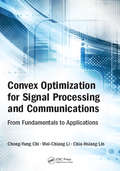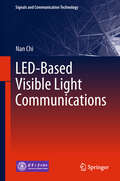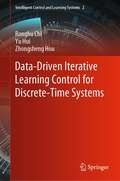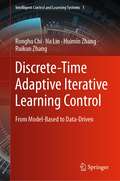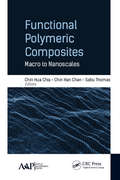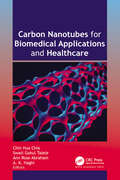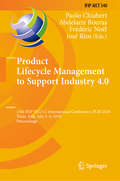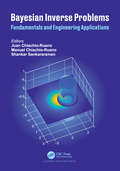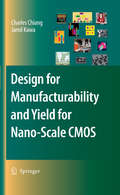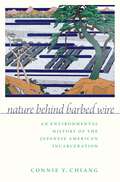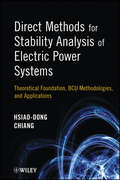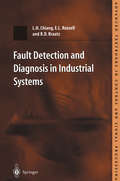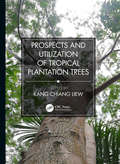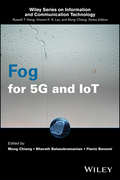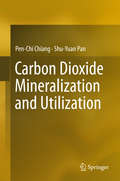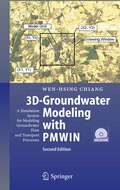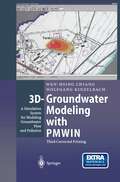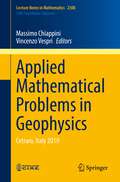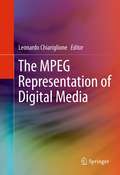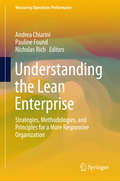- Table View
- List View
Convex Optimization for Signal Processing and Communications: From Fundamentals to Applications
by Chong-Yung Chi Wei-Chiang Li Chia-Hsiang LinConvex Optimization for Signal Processing and Communications: From Fundamentals to Applications provides fundamental background knowledge of convex optimization, while striking a balance between mathematical theory and applications in signal processing and communications. In addition to comprehensive proofs and perspective interpretations for core convex optimization theory, this book also provides many insightful figures, remarks, illustrative examples, and guided journeys from theory to cutting-edge research explorations, for efficient and in-depth learning, especially for engineering students and professionals. With the powerful convex optimization theory and tools, this book provides you with a new degree of freedom and the capability of solving challenging real-world scientific and engineering problems.
LED-Based Visible Light Communications (Signals and Communication Technology)
by Nan ChiThe book systematically introduces the visible light communication (VLC) technology in detail. Basic concepts and how to realize the system are both illustrated, including the transmitter, channel, and the receiver. In addition, a good many experimental results are presented to help readers further understand the VLC technologies. The upper-layer protocols of visible light communication system and the technology trends are also discussed. This book can be a good reference work for researchers, engineers, and graduate students in the fields of communications, LED, and optics.
Data-Driven Iterative Learning Control for Discrete-Time Systems (Intelligent Control and Learning Systems #2)
by Ronghu Chi Yu Hui Zhongsheng HouThis book belongs to the subject of control and systems theory. It studies a novel data-driven framework for the design and analysis of iterative learning control (ILC) for nonlinear discrete-time systems. A series of iterative dynamic linearization methods is discussed firstly to build a linear data mapping with respect of the system’s output and input between two consecutive iterations. On this basis, this work presents a series of data-driven ILC (DDILC) approaches with rigorous analysis. After that, this work also conducts significant extensions to the cases with incomplete data information, specified point tracking, higher order law, system constraint, nonrepetitive uncertainty, and event-triggered strategy to facilitate the real applications. The readers can learn the recent progress on DDILC for complex systems in practical applications. This book is intended for academic scholars, engineers, and graduate students who are interested in learning control, adaptive control, nonlinear systems, and related fields.
Discrete-Time Adaptive Iterative Learning Control: From Model-Based to Data-Driven (Intelligent Control and Learning Systems #1)
by Ronghu Chi Na Lin Huimin Zhang Ruikun ZhangThis book belongs to the subject of control and systems theory. The discrete-time adaptive iterative learning control (DAILC) is discussed as a cutting-edge of ILC and can address random initial states, iteration-varying targets, and other non-repetitive uncertainties in practical applications. This book begins with the design and analysis of model-based DAILC methods by referencing the tools used in the discrete-time adaptive control theory. To overcome the extreme difficulties in modeling a complex system, the data-driven DAILC methods are further discussed by building a linear parametric data mapping between two consecutive iterations. Other significant improvements and extensions of the model-based/data-driven DAILC are also studied to facilitate broader applications. The readers can learn the recent progress on DAILC with consideration of various applications. This book is intended for academic scholars, engineers and graduate students who are interested in learning control, adaptive control, nonlinear systems, and related fields.
Functional Polymeric Composites: Macro to Nanoscales
by Chin Hua Chia Chin Han Chan Sabu ThomasThis new work, Functional Polymeric Composites: Macro to Nanoscales, focuses on new challenges, findings, opportunities, and applications in the area of polymer composites. The chapters, written prominent researchers from academia, industry, and research institutes from around the world, present contemporary research and developments on advanced polymeric materials, including polymer blends, polymer electrolytes, bio-based polymer, polymer nanocomposites, etc. Several chapters also cover the applications of the polymeric systems in current industry development and synthesis and characterization of the products.
Carbon Nanotubes for Biomedical Applications and Healthcare
by Chin Hua Chia Swati Gokul Talele Ann Rose Abraham A. K. HaghiRecent advancements and research in nanotechnology, biotechnology, materials engineering the applications of nanomaterial are evolving. Carbon nanotubes (CNT) and CNT-based systems possess unique chemical, physical, and biological properties that make them good candidates in biomedical applications, but they also have some inherent properties that cause great concern about their biosafety. This volume explores the practical applications of carbon nanotubes in biomedical science and human health. It discusses the synthesis, properties, modification, and recent progress of carbon nanotubes and their applications for biosensing, cancer treatment, antibacterial therapy, tissue engineering, targeted drug delivery, and toxicity. It relays the potential and promise of carbon-based nanomaterials for host of applications while also looking at the challenges in synthesis, characterization, and applications of nanomaterials and how to overcome them.
Product Lifecycle Management to Support Industry 4.0: 15th Ifip Wg 5. 1 International Conference, Plm 2018, Turin, Italy, July 2-4, 2018, Proceedings (IFIP Advances in Information and Communication Technology #540)
by Paolo Chiabert Abdelaziz Bouras Frédéric Noël José RíosThis book constitutes the refereed post-conference proceedings of the 15th IFIP WG 5.1 International Conference on Product Lifecycle Management, PLM 2018, held in Turin, Spain, in July 2018.The 72 revised full papers presented were carefully reviewed and selected from 82 submissions. The papers are organized in the following topical sections: building information modeling; collaborative environments and new product development; PLM for digital factories and cyber physical systems; ontologies and data models; education in the field of industry 4.0; product-service systems and smart products; lean organization for industry 4.0; knowledge management and information sharing; PLM infrastructure and implementation; PLM maturity, implementation and adoption; 3D printing and additive manufacturing; and modular design and products and configuration and change management.
Bayesian Inverse Problems: Fundamentals and Engineering Applications
by Juan Chiachío-RuanoThis book is devoted to a special class of engineering problems called Bayesian inverse problems. These problems comprise not only the probabilistic Bayesian formulation of engineering problems, but also the associated stochastic simulation methods needed to solve them. Through this book, the reader will learn how this class of methods can be useful to rigorously address a range of engineering problems where empirical data and fundamental knowledge come into play. The book is written for a non-expert audience and it is contributed to by many of the most renowned academic experts in this field.
Bayesian Inverse Problems: Fundamentals and Engineering Applications
by Juan Chiachio-Ruano Manuel Chiachio-Ruano Shankar SankararamanThis book is devoted to a special class of engineering problems called Bayesian inverse problems. These problems comprise not only the probabilistic Bayesian formulation of engineering problems, but also the associated stochastic simulation methods needed to solve them. Through this book, the reader will learn how this class of methods can be useful to rigorously address a range of engineering problems where empirical data and fundamental knowledge come into play. The book is written for a non-expert audience and it is contributed to by many of the most renowned academic experts in this field.
Design for Manufacturability and Yield for Nano-Scale CMOS (Integrated Circuits and Systems)
by Charles Chiang Jamil KawaThis book walks the reader through all the aspects of manufacturability and yield in a nano-CMOS process. It covers all CAD/CAE aspects of a SOC design flow and addresses a new topic (DFM/DFY) critical at 90 nm and beyond. This book is a must read book the serious practicing IC designer and an excellent primer for any graduate student intent on having a career in IC design or in EDA tool development.
Nature Behind Barbed Wire: An Environmental History of the Japanese American Incarceration
by Connie Y. ChiangThe mass imprisonment of over 110,000 people of Japanese ancestry during World War II was one of the most egregious violations of civil liberties in United States history. Removed from their homes on the temperate Pacific Coast, Japanese Americans spent the war years in desolate camps in the nation's interior. Photographers including Ansel Adams and Dorothea Lange visually captured these camps in images that depicted the environment as a source of both hope and hardship. And yet the literature on incarceration has most often focused on the legal and citizenship statuses of the incarcerees, their political struggles with the US government, and their oral testimony. Nature Behind Barbed Wire shifts the focus to the environment. It explores how the landscape shaped the experiences of both Japanese Americans and federal officials who worked for the War Relocation Authority (WRA), the civilian agency that administered the camps. The complexities of the natural world both enhanced and constrained the WRA's power and provided Japanese Americans with opportunities to redefine the terms and conditions of their confinement. Even as the environment compounded their feelings of despair and outrage, the incarcerees also found that their agency in transforming and adapting to the natural world could help them survive and contest their incarceration. Japanese Americans and WRA officials negotiated the terms of confinement with each other and with a dynamic natural world. Ultimately, as Connie Chiang demonstrates, the Japanese American incarceration was fundamentally an environmental story.
Nature Behind Barbed Wire: An Environmental History of the Japanese American Incarceration
by Connie Y. ChiangThe mass imprisonment of over 110,000 people of Japanese ancestry during World War II was one of the most egregious violations of civil liberties in United States history. Removed from their homes on the temperate Pacific Coast, Japanese Americans spent the war years in desolate camps in the nation's interior. Photographers including Ansel Adams and Dorothea Lange visually captured these camps in images that depicted the environment as a source of both hope and hardship. And yet the literature on incarceration has most often focused on the legal and citizenship statuses of the incarcerees, their political struggles with the US government, and their oral testimony. Nature Behind Barbed Wire shifts the focus to the environment. It explores how the landscape shaped the experiences of both Japanese Americans and federal officials who worked for the War Relocation Authority (WRA), the civilian agency that administered the camps. The complexities of the natural world both enhanced and constrained the WRA's power and provided Japanese Americans with opportunities to redefine the terms and conditions of their confinement. Even as the environment compounded their feelings of despair and outrage, the incarcerees also found that their agency in transforming and adapting to the natural world could help them survive and contest their incarceration. Japanese Americans and WRA officials negotiated the terms of confinement with each other and with a dynamic natural world. Ultimately, as Connie Chiang demonstrates, the Japanese American incarceration was fundamentally an environmental story.
Direct Methods for Stability Analysis of Electric Power Systems: Theoretical Foundation, BCU Methodologies, and Applications
by Hsiao-Dong ChiangLearn how to implement BCU methods for fast direct stability assessments of electric power systems Electric power providers around the world rely on stability analysis programs to help ensure uninterrupted service to their customers. These programs are typically based on step-by-step numerical integrations of power system stability models to simulate system dynamic behaviors. Unfortunately, this offline practice is inadequate to deal with current operating environments. For years, direct methods have held the promise of providing real-time stability assessments; however, these methods have presented several challenges and limitations. This book addresses these challenges and limitations with the BCU methods developed by author Hsiao-Dong Chiang. To date, BCU methods have been adopted by twelve major utility companies in Asia and North America. In addition, BCU methods are the only direct methods adopted by the Electric Power Research Institute in its latest version of DIRECT 4.0. Everything you need to take full advantage of BCU methods is provided, including: Theoretical foundations of direct methods Theoretical foundations of energy functions BCU methods and their theoretical foundations Group-based BCU method and its applications Numerical studies on industrial models and data Armed with a solid foundation in the underlying theory of direct methods, energy functions, and BCU methods, you'll discover how to efficiently solve complex practical problems in stability analysis. Most chapters begin with an introduction and end with concluding remarks, making it easy for you to implement these tested and proven methods that will help you avoid costly and dangerous power outages.
Direct Methods for Stability Analysis of Electric Power Systems: Theoretical Foundation, BCU Methodologies, and Applications
by Hsiao-Dong ChiangLearn how to implement BCU methods for fast direct stability assessments of electric power systems Electric power providers around the world rely on stability analysis programs to help ensure uninterrupted service to their customers. These programs are typically based on step-by-step numerical integrations of power system stability models to simulate system dynamic behaviors. Unfortunately, this offline practice is inadequate to deal with current operating environments. For years, direct methods have held the promise of providing real-time stability assessments; however, these methods have presented several challenges and limitations. This book addresses these challenges and limitations with the BCU methods developed by author Hsiao-Dong Chiang. To date, BCU methods have been adopted by twelve major utility companies in Asia and North America. In addition, BCU methods are the only direct methods adopted by the Electric Power Research Institute in its latest version of DIRECT 4.0. Everything you need to take full advantage of BCU methods is provided, including: Theoretical foundations of direct methods Theoretical foundations of energy functions BCU methods and their theoretical foundations Group-based BCU method and its applications Numerical studies on industrial models and data Armed with a solid foundation in the underlying theory of direct methods, energy functions, and BCU methods, you'll discover how to efficiently solve complex practical problems in stability analysis. Most chapters begin with an introduction and end with concluding remarks, making it easy for you to implement these tested and proven methods that will help you avoid costly and dangerous power outages.
Fault Detection and Diagnosis in Industrial Systems (Advanced Textbooks in Control and Signal Processing)
by L.H. Chiang E.L. Russell R.D. BraatzEarly and accurate fault detection and diagnosis for modern chemical plants can minimize downtime, increase the safety of plant operations, and reduce manufacturing costs. This book presents the theoretical background and practical techniques for data-driven process monitoring. It demonstrates the application of all the data-driven process monitoring techniques to the Tennessee Eastman plant simulator, and looks at the strengths and weaknesses of each approach in detail. A plant simulator and problems allow readers to apply process monitoring techniques.
Prospects and Utilization of Tropical Plantation Trees
by Liew Kang ChiangLarge numbers of tropical trees from natural forests or plantation forest are available for human consumption and management. This book focuses on the prospects and utilization of tropical plantation trees in context of economic and business, planting, managing stocks, and uses of trees converted to various wood-based products. It provides information on key areas of tropical plantation trees including growth performance, nursery practices, soil properties, planting stock production, raw material cellulose, anatomy, pulping and papermaking, fiber modification, and properties of wood composites. Features: Comprehensive information on prospects and utilization of tropical plantation tree species. Features information on potential products derived from tropical plantation trees including cellulose-based wood products, particleboard with bioplastic binder, and laminated veneer lumber. Discusses species usage of economic importance other than wood production. Presents information on nursery practices, growth performance, and soil properties of tropical trees. Illustrates methodologies for repeating investigations on work that has been done previously in tropical tree research. This book introduces information for entrepreneurs or researchers before undertaking work with these tree species illustrating technical methodologies allowing for repetition or previous successful works. This information proves valuable to researchers if further work is needed for improvement on these plant-derived products.
Fog for 5G and IoT (Information and Communication Technology Series,)
by Mung Chiang Bharath Balasubraman Flavio BonomiThe book examines how Fog will change the information technology industry in the next decade. Fog distributes the services of computation, communication, control and storage closer to the edge, access and users. As a computing and networking architecture, Fog enables key applications in wireless 5G, the Internet of Things, and big data. The authors cover the fundamental tradeoffs to major applications of fog. The book chapters are designed to motivate a transition from the current cloud architectures to the Fog (Chapter 1), and the necessary architectural components to support such a transition (Chapters 2-6). The rest of the book (Chapters 7-xxx) are dedicated to reviewing the various 5G and IoT applications that will benefit from Fog networking. This volume is edited by pioneers in Fog and includes contributions by active researchers in the field. Covers fog technologies and describes the interaction between fog and cloud Presents a view of fog and IoT (encompassing ubiquitous computing) that combines the aspects of both industry and academia Discusses the various architectural and design challenges in coordinating the interactions between M2M, D2D and fog technologies "Fog for 5G and IoT" serves as an introduction to the evolving Fog architecture, compiling work from different areas that collectively form this paradigm
Fog for 5G and IoT (Information and Communication Technology Series,)
by Mung Chiang Bharath Balasubramanian Flavio BonomiThe book examines how Fog will change the information technology industry in the next decade. Fog distributes the services of computation, communication, control and storage closer to the edge, access and users. As a computing and networking architecture, Fog enables key applications in wireless 5G, the Internet of Things, and big data. The authors cover the fundamental tradeoffs to major applications of fog. The book chapters are designed to motivate a transition from the current cloud architectures to the Fog (Chapter 1), and the necessary architectural components to support such a transition (Chapters 2-6). The rest of the book (Chapters 7-xxx) are dedicated to reviewing the various 5G and IoT applications that will benefit from Fog networking. This volume is edited by pioneers in Fog and includes contributions by active researchers in the field. Covers fog technologies and describes the interaction between fog and cloud Presents a view of fog and IoT (encompassing ubiquitous computing) that combines the aspects of both industry and academia Discusses the various architectural and design challenges in coordinating the interactions between M2M, D2D and fog technologies "Fog for 5G and IoT" serves as an introduction to the evolving Fog architecture, compiling work from different areas that collectively form this paradigm
Multi-Pollutant Control for Flue Gases: Principles and Applications (Advanced Topics in Science and Technology in China #63)
by Pen-Chi Chiang Kefa Cen Xiang Gao Chenghang ZhengThis book presents the latest multi-pollutant (mainly NOx, SOx, particulate matter, heavy metals) control technologies for flue gases and the applications in coal-fired power plants. Pollutant control by catalytic, electric, and absorption methods, the multi-pollutant removal system and its performance evaluation are systematically introduced. This book is a valuable reference for researchers and practitioners in environmental science & engineering, energy power engineering, and chemical science & engineering, etc.
Carbon Dioxide Mineralization and Utilization
by Pen-Chi Chiang Shu-Yuan PanThis book focuses on an important technology for mineralizing and utilizing CO2 instead of releasing it into the atmosphere. CO2 mineralization and utilization demonstrated in the waste-to-resource supply chain can “reduce carbon dependency, promote resource and energy efficiency, and lessen environmental quality degradation,” thereby reducing environmental risks and increasing economic benefits towards Sustainable Development Goals (SDG). In this book, comprehensive information on CO2 mineralization and utilization via accelerated carbonation technology from theoretical and practical considerations was presented in 20 Chapters. It first introduces the concept of the carbon cycle from the thermodynamic point of view and then discusses principles and applications regarding environmental impact assessment of carbon capture, storage and utilization technologies. After that, it describes the theoretical and practical considerations for “Accelerated Carbonation (Mineralization)” including analytical methods, and systematically presents the carbonation mechanism and modeling (process chemistry, reaction kinetics and mass transfer) and system analysis (design and analysis of experiments, life cycle assessment and cost benefit analysis). It then provides physico-chemical properties of different types of feedstock for CO2 mineralization and then explores the valorization of carbonated products as green materials. Lastly, an integral approach for waste treatment and resource recovery is introduced, and the carbonation system is critically assessed and optimized based on engineering, environmental, and economic (3E) analysis. The book is a valuable resource for readers who take scientific and practical interests in the current and future Accelerated Carbonation Technology for CO2 Mineralization and Utilization.
3D-Groundwater Modeling with PMWIN: A Simulation System for Modeling Groundwater Flow and Transport Processes
by Wen-Hsing ChiangThis book offer a complete simulation system for modeling groundwater flow and transport processes. The companion full-version software (PMWIN) comes with a professional graphical user-interface, supported models and programs and several other useful modeling tools. Tools include a Presentation Tool, a Result Extractor, a Field Interpolator, a Field Generator, a Water Budget Calculator and a Graphic Viewer. Book targeted at novice and experienced groundwater modelers.
3D-Groundwater Modeling with PMWIN: A Simulation System for Modeling Groundwater Flow and Pollution
by Wen-Hsing Chiang Wolfgang KinzelbachThis book and CD-ROM offer a complete simulation system for modeling groundwater flow and transport processes. The companion full-version software (PMWIN) comes with a professional graphical user-interface, supported models and programs and several other useful modeling tools. Tools include a Presentation Tool, a Result Extractor, a Field Interpolator, a Field Generator, a Water Budget Calculator and a Graphic Viewer. Book and CD-ROM are targeted at novice and experienced groundwater modelers.
Applied Mathematical Problems in Geophysics: Cetraro, Italy 2019 (Lecture Notes in Mathematics #2308)
by Massimo Chiappini Vincenzo VespriThis CIME Series book provides mathematical and simulation tools to help resolve environmental hazard and security-related issues.The contributions reflect five major topics identified by the SIES (Strategic Initiatives for the Environment and Security) as having significant societal impact: optimal control in waste management, in particular the degradation of organic waste by an aerobic biomass, by means of a mathematical model; recent developments in the mathematical analysis of subwave resonators; conservation laws in continuum mechanics, including an elaboration on the notion of weak solutions and issues related to entropy criteria; the applications of variational methods to 1-dimensional boundary value problems, in particular to light ray-tracing in ionospheric physics; and the mathematical modelling of potential electromagnetic co-seismic events associated to large earthquakes.This material will provide a sound foundation for those who intend to approach similar problems from a multidisciplinary perspective.
The MPEG Representation of Digital Media
by Leonardo ChiariglioneMore and more information, audio and video but also a range of other information type, is generated, processed and used by machines today, even though the end user may be a human. The result over the past 15 years has been a substantial increase in the type of information and change in the way humans generate, classify, store, search, access and consume information. Conversion of information to digital form is a prerequisite for this enhanced machine role, but must be done having in mind requirements such as compactness, fidelity, interpretability etc. This book presents new ways of dealing with digital information and new types of digital information underpinning the evolution of society and business.
Understanding the Lean Enterprise: Strategies, Methodologies, and Principles for a More Responsive Organization (Measuring Operations Performance)
by Andrea Chiarini Pauline Found Nicholas RichThis publication is in collaboration with the University of Buckingham and is the result of a combined research and review process carried out by the three Editors who belongs to the University of Ferrara, Italy, the University of Buckingham, UK and Swansea University, UK.The book deepens the debate about the lean enterprise from both an academic and a professional management perspective. It thus provides the reader with a sound understanding of the modern lean enterprise and its current evolution. A range of innovative topics are covered, with individual chapters addressing the combinations of lean with hoshin kanri, green management, IT, organizational learning, flow accounting, system thinking, problem solving, internationalization aspects, luxury industry, and product innovation.Since the term “lean” first entered contemporary operations management language in 1990 to describe a set of practices proven to deliver superior performance over mass production systems, the lean approach to waste reduction and value generation has moved from vehicle production to other manufacturing sectors. It has reshaped the support functions of manufacturing businesses and has evolved from private industry into the public sector. Lean thinking is now a dominant model of operations management and has brought with it a new language and toolbox.
